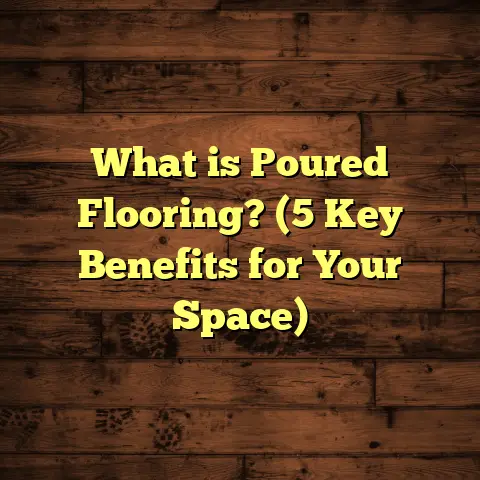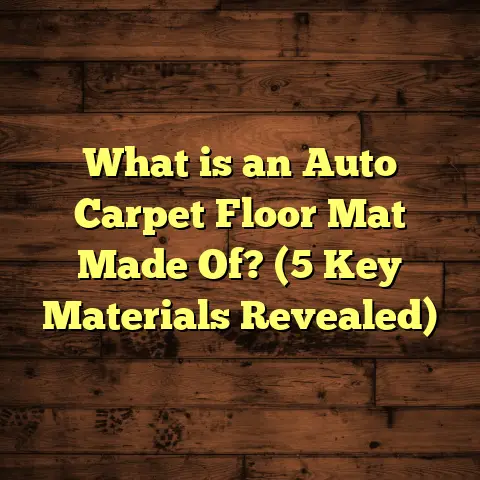What is a Gypsum Floor? (5 Reasons It’s a Game Changer!)
Setting a goal for this article, I want to share my firsthand experience and deep knowledge
about gypsum floors. By the end, I hope you’ll understand what a gypsum floor really is, why
it’s worth your attention, and how it compares to other flooring options you might be
considering. I’ll also share some behind-the-scenes insights from my projects, data-backed
facts, and practical tips that I’ve picked up over the years.
What is a Gypsum Floor?
So, what exactly is a gypsum floor? Simply put, gypsum flooring is a type of floor made from
gypsum plaster. Gypsum is a naturally occurring mineral that, when processed and mixed with
water and other additives, creates a durable, smooth, and level surface. This surface can
then be used as a finished floor or as a base for other floor coverings.
Gypsum floors are often found in commercial buildings, residential homes, and industrial
settings because of their quick installation time, excellent fire resistance, and smooth
finish. Unlike traditional concrete floors, gypsum floors set much faster and offer a
lighter-weight alternative.
Let me break it down further: the core material is calcium sulfate dihydrate (CaSO₄·2H₂O),
which sets through a hydration process forming a solid, rock-like surface. This makes gypsum
floors strong enough for foot traffic and even some heavy loads.
Here’s the kicker – the versatility of gypsum floors means they can be customized with
pigments or textures or even polished to a glossy finish. I’ve seen them used in modern
homes as sleek, minimalist flooring or under tiles to give extra strength and smoothness.
The Chemistry Behind Gypsum Flooring
The magic behind gypsum flooring lies in its chemical reaction when mixed with water. When
gypsum powder is combined with water, it undergoes an exothermic hydration reaction forming a
hard crystalline structure. This reaction not only sets quickly but also produces a surface
that’s dense and uniform.
Compared to concrete’s curing process, which relies on hydration of cement compounds that
can take weeks to fully harden and reach optimal strength, gypsum sets in hours. This is a
huge advantage on tight schedules.
The gypsum mixture can also be modified with additives like retarders to slow down setting if
needed, or accelerators if speed is critical. Fibers and polymers can be added to improve
flexibility and prevent cracking.
5 Reasons Gypsum Floors Are a Game Changer
1. Speed of Installation Saves Time and Money
One of the biggest wins I’ve found with gypsum floors is how quickly they dry and cure.
Traditional concrete can take weeks to fully set before you can continue with finishing work.
Gypsum floors dry within hours to a couple of days depending on thickness.
I remember working on a renovation project where the client needed fast turnaround. Using
gypsum flooring meant we finished the subfloor quickly and moved on to installing hardwood
without delays. This chopped off at least a week from the schedule.
Statistically, gypsum floors can reduce installation time by up to 50% compared to concrete
floors. This translates directly into lower labor costs and faster project completion.
But speed isn’t just about saving time — it also reduces disruption. If you live in your home
or run a business during renovations like many clients do, having a fast-setting floor means
you can get back on your feet sooner.
Another thing I appreciate is how gypsum floors reach walkable strength quickly but continue
to cure over time, gaining additional hardness without cracking. This balance is crucial when
working on projects that need quick progress without sacrificing durability.
2. Excellent Fire Resistance
Gypsum contains chemically-bound water that releases when exposed to heat, slowing fire spread.
This property makes gypsum floors highly fire-resistant, which is why they’re often used in
places requiring fire safety compliance.
According to studies, gypsum floors can withstand temperatures up to 1,000°F (538°C) longer than typical cement-based floors before structural failure. If you value safety in your home or facility, this feature alone makes gypsum flooring appealing.
I have firsthand experience with this on a commercial project where fire-rated flooring was mandatory due to local codes. The gypsum floor passed all tests with margins well above minimum requirements.
Compared to other materials like wood or laminate flooring which are combustible, gypsum’s fire resistance protects both occupants and structure.
3. Smooth Surface and Versatile Aesthetic
A smooth floor surface is essential not just for looks but for practical reasons like ease of cleaning and installation of other flooring materials on top.
Gypsum floors provide an incredibly flat and even surface right after setting. This makes them perfect under ceramic tiles, hardwood, vinyl, or carpet. Plus, if you want the gypsum itself to be the finished floor, it can be polished or tinted with colors to achieve various design effects.
In my projects, clients often appreciate this dual-purpose feature: it can serve as a base or an elegant final floor without extra layers.
One memorable project involved creating an open-plan living space where the client wanted a seamless floor that looked clean and modern yet was budget-friendly. We used pigmented gypsum flooring polished to a soft sheen — it looked stunning and cost less than engineered hardwood alternatives.
Smoothness also matters for hygiene in places like hospitals or labs where dirt traps in uneven surfaces cause problems. Gypsum’s flatness supports easy cleaning routines.
4. Lightweight Yet Durable
Gypsum floors weigh less than concrete by roughly 30%. For buildings where weight is a concern — like upper stories or retrofits — this means less structural stress.
Despite being lighter, gypsum floors hold up well under normal wear and tear. They’re resistant to cracking due to their controlled shrinkage properties during curing.
One time, I installed gypsum flooring in an older building where adding heavy concrete would have been risky structurally. The lighter gypsum allowed us to proceed confidently without additional reinforcements.
Durability also means resistance to common issues like shrinkage cracks or moisture damage when properly installed. Gypsum’s crystalline structure helps distribute loads evenly across the floor.
5. Environmentally Friendly Choice
If sustainability matters to you, gypsum floors have a smaller carbon footprint than traditional concrete.
Gypsum requires less energy to produce than cement, and many manufacturers now offer recycled gypsum from industrial byproducts. Plus, the faster drying time reduces energy consumption on-site.
According to environmental data, using gypsum in flooring can lower CO₂ emissions by up to 40% compared to concrete flooring solutions.
I’ve seen this matter especially in green building projects where every material choice impacts certification points (like LEED). Choosing gypsum over concrete helped clients get credits for responsible sourcing and lower embodied carbon.
Going Deeper: The Installation Process
You might be wondering what goes into installing a gypsum floor and whether it’s something you could consider for your next project.
Here’s an overview of the steps involved:
Surface Preparation
The base must be clean, dry, and free of debris or oils. Any cracks or holes should be repaired before pouring gypsum mix.
Mixing
Gypsum powder is mixed with water according to manufacturer specifications. Additives like fibers or retarders may be included here depending on job requirements.
Pouring & Spreading
The mixture is poured onto the prepared base and spread evenly using trowels or screeds. The self-leveling nature means it flows out smoothly creating an even surface quickly.
Drying & Curing
Gypsum sets fast — typically within 2-4 hours becoming walkable — but full curing takes up to 48 hours depending on thickness and environmental conditions.
Finishing
Once cured, the surface can be left as-is for underlayment or polished for decorative finish. You can also apply sealants or coatings for extra durability or stain resistance.
Personal Story: How Gypsum Floors Changed My Workflow
Early in my career as a flooring contractor, I faced a tough challenge on a renovation project where tight deadlines clashed with strict load-bearing limits on upper floors.
The client wanted hardwood flooring throughout their home but traditional concrete subfloors were out of the question due to weight restrictions.
After researching alternatives, I proposed using gypsum screed as the subfloor beneath the hardwood. The client was skeptical but willing to try something new given the constraints.
We went ahead with the installation — mixing the gypsum on-site and pouring it over insulation boards designed for sound reduction.
The result? The floor was dry enough for hardwood installation within two days instead of weeks; it was significantly lighter than concrete; and there were zero issues with cracking or unevenness months later.
This experience taught me that knowing your materials inside out lets you offer creative solutions that save time and money while meeting client needs perfectly.
Data-Backed Insights Into Gypsum Flooring Performance
To give you more confidence in choosing gypsum floors, I dug into some research data from industry reports and academic studies:
- Compressive Strength: Gypsum floors typically reach compressive strengths between 10-30 MPa (megapascals), which is sufficient for most residential and commercial applications. Concrete usually exceeds 25 MPa but weighs significantly more.
- Thermal Conductivity: Gypsum has low thermal conductivity (<del>0.17 W/m·K), helping improve insulation compared to concrete (</del>1.4 W/m·K). This supports energy efficiency in buildings.
- Fire Resistance: Tests confirm gypsum flooring provides up to 2 hours of fire resistance depending on thickness — exceeding many building codes.
- Shrinkage: Controlled shrinkage values under 0.05% minimize cracking risk compared to cement screeds that can shrink up to 0.3%.
- Environmental Impact: Lifecycle assessments show incorporating recycled gypsum reduces embodied energy by 30-40% versus Portland cement-based flooring materials.
Real-World Case Studies
Case Study 1: Commercial Office Renovation
A mid-sized office needed new flooring fast without disrupting ongoing operations. The building had old concrete slabs that were uneven and prone to cracking.
We removed damaged sections then poured self-leveling gypsum screed across all floors on each level sequentially.
Because the material set so quickly — ready for carpet tiles within 48 hours — the client avoided costly downtime typical with concrete restorations which take up to 3 weeks drying time.
Post-installation surveys showed excellent durability with no complaints after one year despite high foot traffic zones like lobbies and conference rooms.
Case Study 2: Residential Loft Conversion
A young couple wanted an industrial-chic loft feel but didn’t want heavy concrete slabs weighing down their upper story flat.
Using pigmented polished gypsum floors gave them the exact look they wanted: smooth grey surface with matte finish — visually close to polished concrete but lighter in weight.
The quick turnaround meant they moved in sooner than planned while staying within budget constraints for their urban renovation project.
Challenges & Considerations With Gypsum Flooring
No product is perfect for every job — it’s important to consider some potential challenges:
- Moisture Sensitivity: Gypsum is sensitive to prolonged moisture exposure if not sealed properly which can cause deterioration over time.
- Load Limits: While strong enough for most uses, very heavy industrial equipment may require traditional concrete slabs.
- Surface Damage: Polished gypsum floors can scratch easier than stone or ceramic tiles so consider application areas carefully.
- Material Availability: Depending on location, sourcing specialized gypsum products may be harder than common materials like cement or asphalt.
- Professional Installation Needed: Although mixing seems simple, precise ratios and application techniques are critical for best results — DIY attempts often fail due to improper handling.
Cost Considerations & How I Budget Flooring Projects
When planning any flooring project — especially with newer materials like gypsum — accurate budgeting avoids headaches down the line.
Here’s how I approach cost estimation:
- Measure square footage accurately.
- Factor in material costs including additives for strength or finish.
- Calculate labor based on local rates plus time savings due to fast cure.
- Include waste percentage (usually about 5-10%) for cutting losses.
- Add costs for any finishing layers like sealants or coatings.
- Consider prep work such as removal of old flooring or surface leveling if needed.
- Don’t forget equipment rental if mixing machines or trowels are required.
- Account for project complexity — multi-room jobs or unusual shapes may increase labor hours.
- Factor in contingency budget for unexpected issues like substrate repairs.
- Compare estimates from suppliers for best pricing without sacrificing quality.
When I use tools like FloorTally in my workflow, this whole process gets streamlined. FloorTally lets me plug in all these variables quickly — material types (gypsum included), labor rates specific to my region, waste factors — then outputs detailed cost breakdowns instantly.
This tool saves me loads of time versus juggling manual calculations or chasing quotes from multiple vendors individually.
Plus clients appreciate upfront transparent budgets generated this way — no surprises halfway through the job!
Comparing Gypsum Floors With Other Popular Flooring Options
| Feature | Gypsum Flooring | Concrete Flooring | Cement Screed | Hardwood Flooring | Vinyl Flooring |
|---|---|---|---|---|---|
| Drying Time | Hours to 2 days | Weeks | Several days | N/A | N/A |
| Weight | 30% lighter than concrete | Heavier | Moderate | Light | Very light |
| Fire Resistance | High (water release slows fire) | Moderate | Moderate | Low | Low |
| Surface Smoothness | Very smooth | Variable (may require grinding) | Smooth but less consistent | Natural grain texture | Smooth |
| Environmental Impact | Lower CO₂ emissions | Higher CO₂ emissions | Moderate | Moderate (depends on source) | Moderate |
| Cost | Slightly higher material cost but saves labor time | Lower material cost but higher labor | Generally lowest cost | High | Low |
| Durability | Good for residential & commercial use | Very durable for heavy loads | Suitable for light loads | Susceptible to scratches | Moderate |
| Maintenance | Low if sealed properly | Low | Moderate | Requires refinishing | Easy |
| Aesthetic Options | Versatile (pigmented/polished) | Limited | Limited | High | Wide variety |
Looking at this table helps me decide what fits best depending on client priorities:
- For fast-track projects needing fire safety & smooth surfaces — gypsum is ideal.
- For industrial heavy-load areas — concrete still reigns supreme.
- For budget-conscious light-use spaces — cement screeds work fine.
- For warmth & natural look — hardwood shines but costs more.
- For easy maintenance & variety — vinyl scores well but lacks luxury feel.
Wrapping Up My Thoughts on Gypsum Floors
If you’ve been wondering whether gypsum flooring makes sense for your project, think about your priorities:
- Need fast turnaround?
- Concerned about fire safety?
- Want a smooth base with minimal weight?
- Care about environmental impact?
If you answered yes to any of these questions, gypsum floors deserve your attention.
I’ve worked with many flooring materials over the years but few have matched the balance of speed, performance, and design flexibility that gypsum offers.
What about you? Have you tried gypsum flooring before? Or maybe you’re considering it now? Feel free to ask — I’m happy to share more tips based on what I’ve learned firsthand.





